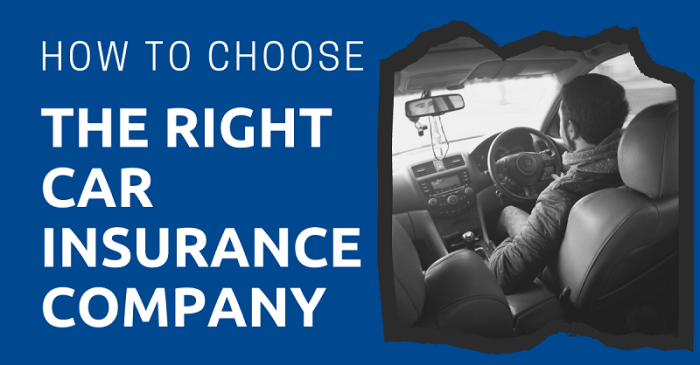How to choose the right auto insurance is crucial for every car owner. From understanding coverage needs to evaluating deductibles and premiums, this guide will help you navigate the complex world of auto insurance with ease.
Whether you’re a new driver or looking to switch providers, making informed decisions about your auto insurance is essential to protect yourself and your vehicle.
Understand Your Coverage Needs
When it comes to choosing the right auto insurance, understanding your coverage needs is crucial. Different types of coverage are available to protect you and your vehicle in various situations. Factors such as your driving habits, the value of your car, and your budget will influence the type and amount of coverage you require. Additionally, it’s essential to be aware of your state’s requirements for auto insurance to ensure you meet the legal obligations.
Types of Auto Insurance Coverage, How to choose the right auto insurance
- Liability Coverage: Protects you if you are at fault in an accident and covers the other party’s medical expenses and property damage.
- Collision Coverage: Pays for repairs to your vehicle in case of a collision with another vehicle or object.
- Comprehensive Coverage: Covers damage to your car from incidents other than collisions, such as theft, vandalism, or natural disasters.
- Uninsured/Underinsured Motorist Coverage: Protects you if you are involved in an accident with a driver who has insufficient or no insurance.
Factors to Consider for Choosing Coverage
- Value of Your Vehicle: Consider the age, make, and model of your car to determine the level of coverage needed.
- Driving Habits: Evaluate how often and where you drive to assess the risk of accidents and the need for comprehensive coverage.
- Financial Situation: Determine how much you can afford to pay out of pocket in case of an accident and select coverage accordingly.
Importance of Understanding State Requirements
- Each state has specific laws regarding auto insurance requirements, including minimum coverage limits.
- Failure to meet these requirements can result in fines, license suspension, or other legal consequences.
- Knowing your state’s mandates ensures you have the necessary coverage to protect yourself and comply with the law.
Research Insurance Providers
When choosing the right auto insurance, it is essential to research insurance providers to find the best coverage for your needs. Here are some key points to consider when researching insurance companies:
List of Reputable Auto Insurance Companies
- Geico
- Progressive
- Allstate
- State Farm
- USAA (for military members and their families)
Compare Financial Strength and Customer Reviews
Before selecting an insurance provider, it is crucial to compare their financial strength and customer reviews. A financially stable insurance company is more likely to honor claims and provide reliable service. Additionally, reading customer reviews can give you insight into the customer experience and satisfaction levels.
When it comes to eco-friendly driving, the market offers a variety of options to choose from. One of the top choices is investing in top hybrid cars for eco-friendly driving , which not only help reduce emissions but also offer great fuel efficiency.
On the other hand, if you’re looking for budget-friendly options, you can explore a range of fuel efficient cars under $20,000 that are designed to save you money on gas without compromising on performance.
Benefits of Choosing a Well-Established Insurance Company
- Experience and Expertise: Well-established insurance companies often have years of experience and expertise in the industry, allowing them to offer comprehensive coverage options and superior customer service.
- Financial Stability: Choosing a well-established insurance company ensures that they have the financial strength to pay out claims in a timely manner, providing you with peace of mind.
- Reputation: Established insurance companies have built a solid reputation over time, making them more trustworthy and reliable in the eyes of customers.
Evaluate Deductibles and Premiums: How To Choose The Right Auto Insurance

When choosing the right auto insurance policy, it is essential to carefully evaluate deductibles and premiums. These two factors play a significant role in determining the cost of your insurance and the coverage you receive.
Relationship between Deductibles and Premiums
The deductible is the amount you agree to pay out of pocket before your insurance coverage kicks in. Generally, the higher the deductible, the lower your premium will be. This is because you are taking on more financial responsibility in the event of a claim, so the insurance company charges you a lower premium.
- Consider your budget and how much you can afford to pay out of pocket in the event of an accident.
- Balance your deductible with your premium to find a level that works best for your financial situation.
Choosing the Right Deductible Amount
Tip: Opt for a higher deductible if you have savings set aside to cover it, as this can lower your premium significantly.
When deciding on the right deductible amount, it is essential to consider your budget and financial capabilities. While a higher deductible can lead to lower premiums, make sure you can comfortably cover the deductible amount if needed.
Calculating Premiums and Lowering Costs
Premiums are calculated based on various factors such as your age, driving record, location, and the type of vehicle you drive. To lower your premium costs, you can consider the following:
- Bundle your auto insurance with other policies like home or renters insurance for potential discounts.
- Take advantage of safe driver discounts by maintaining a clean driving record.
- Consider opting for a usage-based insurance policy where your premium is based on your actual driving habits.
Consider Additional Coverage Options

When choosing auto insurance, it’s important to consider additional coverage options beyond the basic requirements. These optional coverages can provide added protection in various situations and help you tailor your policy to fit your needs.
- Comprehensive Coverage:
Comprehensive coverage helps pay for damage to your vehicle that is not caused by a collision, such as theft, vandalism, or natural disasters. This coverage can be especially valuable if you live in an area prone to extreme weather or high rates of vehicle theft.
- Collision Coverage:
Collision coverage helps cover the cost of repairing or replacing your vehicle if it is damaged in a collision with another vehicle or object. This coverage is essential if you have a newer or more valuable car that would be expensive to repair or replace out of pocket.
- Uninsured/Underinsured Motorist Coverage:
Uninsured/Underinsured Motorist coverage protects you if you are involved in an accident with a driver who does not have insurance or does not have enough insurance to cover your expenses. This coverage can help pay for medical bills, lost wages, and other damages resulting from the accident.
Benefits of Additional Coverage Options
Adding these optional coverages to your auto insurance policy can provide peace of mind and financial protection in various situations. By having comprehensive, collision, and uninsured/underinsured motorist coverage, you can ensure that you are adequately protected in case of unexpected events on the road.
- Peace of Mind:
Knowing that you have additional coverage beyond the basic requirements can give you peace of mind while driving, knowing that you are financially protected in a wider range of scenarios.
- Financial Protection:
With additional coverage options, you can avoid significant out-of-pocket expenses in the event of theft, vandalism, collisions, or accidents with uninsured motorists. This financial protection can help you avoid financial hardship and stress during already challenging situations.
Scenarios Where Additional Coverage May Be Necessary
There are several scenarios where opting for additional coverage options may be necessary to ensure you are adequately protected on the road:
- Living in High-Risk Areas:
If you live in an area prone to extreme weather, high rates of vehicle theft, or frequent collisions, comprehensive and collision coverage can be crucial to protect your vehicle from potential damages.
- Driving a New or Valuable Vehicle:
If you drive a newer or more valuable vehicle, having comprehensive and collision coverage can help cover the cost of repairs or replacement in case of an accident, protecting your investment in the vehicle.
- Encountering Uninsured Drivers:
In regions where uninsured drivers are common, uninsured/underinsured motorist coverage can be essential to cover expenses resulting from accidents with drivers who lack proper insurance coverage.
Review Policy Features and Exclusions

When choosing the right auto insurance policy, it is crucial to review the specific features and exclusions included in the coverage. Understanding what your policy includes and excludes can help you make informed decisions and avoid any surprises in the event of an accident or claim.
Common Policy Features
- Roadside Assistance: Many auto insurance policies offer roadside assistance as an optional add-on or included feature. This can provide you with support in case of a breakdown, flat tire, or other roadside emergencies.
- Rental Car Coverage: Some policies may also include coverage for rental cars if your vehicle is in the shop for repairs after an accident. This can help you stay mobile while your car is being fixed.
Identifying Exclusions
- Exclusions in auto insurance policies can vary depending on the provider and type of coverage. Common exclusions may include intentional damage, racing, or using your vehicle for commercial purposes.
- It is essential to carefully read the fine print of your policy to understand any exclusions that may apply. Being aware of what is not covered can help you avoid potential gaps in coverage when you need it most.
Importance of Reading the Fine Print
Reading the fine print of your auto insurance policy is crucial to fully comprehend the coverage details and limitations. It can help you understand what is included, excluded, and any specific conditions that may apply to your policy.
By taking the time to review policy features and exclusions, you can ensure that you have the right coverage for your needs and make informed decisions when selecting an auto insurance policy.
Final Wrap-Up
In conclusion, selecting the right auto insurance involves careful consideration of your needs, research on providers, and understanding policy details. By following the tips Artikeld in this guide, you can confidently choose the auto insurance that best suits you.
When it comes to eco-friendly driving, hybrid cars are a top choice. These vehicles offer a combination of electric and gasoline power, reducing emissions and saving fuel. If you’re looking for the best hybrid cars available, check out this list of the top hybrid cars for eco-friendly driving.
For budget-conscious drivers, fuel-efficient cars under $20,000 are a great option. These vehicles prioritize fuel economy without sacrificing performance. If you’re in the market for an affordable and efficient car, take a look at this selection of fuel-efficient cars under $20,000.